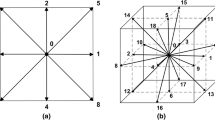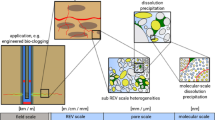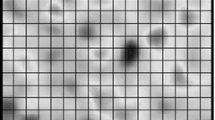Abstract
Preferential flow is still an elusive phenomenon in porous media, impacting the oil industry, micro- and nanofluidic applications, and soil sciences. The Lattice Boltzmann Method (LBM) with the Pore-Scale approach is a robust mesoscopic tool for modeling flows in complex geometries, detailing velocity fields, and identifying preferred pathways. Since preferential flow has several causes, it is hard to distinguish and evaluate the different contributions to the phenomenon. However, a starting simplification assumes that geometrical features are its primary cause. In this work, we discuss some insights about preferential flow and verify the validity of a previous tortuosity-dependent resistance model in a non-Darcy regime. Initially, we demonstrate that the Pore-Scale LBM recovers the Forchheimer empirical model. Although the tortuosity model reasonably predicts many preferred pathways, the inertial contributions in the Forchheimer regime make the porous pattern, grain shape, and path deflections disturb those predictions. The simulations indicate that paths with minor flow resistances affect the neighboring flow preferences. Dead zones arise by imposing clogging conditions, and the flow field and preferred paths change. Wondering how the observed preferential routes impact the evolution of a reactive flow, a mass transport analysis was carried out to track the porosity evolution during the reactive dissolution of the solid structures. As a result, the matrix porosity increases over time, especially under diffusion- and kinetic-dominated conditions.











Similar content being viewed by others
Data Availability
The datasets generated and analyzed during the current study are available from the corresponding author on reasonable request.
Code Availability
The code used during this current study is available from the corresponding author on a reasonable request.
References
Bhagat AAS, Kuntaegowdanahalli SS, Papautsky I (2009) Inertial microfluidics for continuous particle filtration and extraction. Microfluid Nanofluid 7:217–226. https://doi.org/10.1007/s10404-008-0377-2
Bhatnagar PL, Gross EP, Krook M (1954) A model for collision processes in gases I: small amplitude processes in charged and neutral one-component systems. Phys Rev 94:511–525. https://doi.org/10.1103/PhysRev.94.511
Blunt MJ (2017) Multiphase Flow in Permeable Media: a pore-scale perspective. Cambridge University Press, Cambridge
Blunt MJ, Bijeljic B, Dong H et al (2013) Pore-scale imaging and modelling. Adv Water Resour 51:197–216. https://doi.org/10.1016/j.advwatres.2012.03.003
Calçada LA, Duque Neto OA, Magalhães SC et al (2015) Evaluation of suspension flow and particulate materials for control of fluid losses in drilling operation. J Pet Sci Eng 131:1–10. https://doi.org/10.1016/j.petrol.2015.04.007
Clennell M, Ben (1997) Tortuosity: a guide through the maze. Geol Soc Lond Spec Publ 122:299–344. https://doi.org/10.1144/GSL.SP.1997.122.01.18
Clothier BE, Green SR, Deurer M (2008) Preferential flow and transport in soil: Progress and prognosis. Eur J Soil Sci 59:2–13. https://doi.org/10.1111/j.1365-2389.2007.00991.x
D’Humierès D (1992) Generalized lattice-boltzmann equations, Rarefied Gas Dynamics: theory and simulations. Prog Astronaut Aeronaut 159:450–458. https://doi.org/10.2514/5.9781600866319.0450.0458
Donath A, Kantzas A, Bryant S (2019) Opportunities for particles and particle suspensions to experience enhanced transport in porous media: a review. Transp Porous Med 128:459–509. https://doi.org/10.1007/s11242-019-01256-4
Dukhin AS, Goetz PJ (2009) Bulk viscosity and compressibility measurement using acoustic spectroscopy. J Chem Phys 130. https://doi.org/10.1063/1.3095471
Dusek J, Vogel T, Dohnal M, Gerke HH (2012) Combining dual-continuum approach with diffusion wave model to include a preferential flow component in hillslope scale modeling of shallow subsurface runoff. Adv Water Resour 44:113–125. https://doi.org/10.1016/j.advwatres.2012.05.006
Fan D, Chapman E, Khan A et al (2022) Anomalous transport of colloids in heterogeneous porous media: a multi-scale statistical theory. J Colloid Interface Sci 617:94–105. https://doi.org/10.1016/j.jcis.2022.02.127
Fishkis O, Noell U, Diehl L et al (2020) Multitracer irrigation experiments for assessing the relevance of preferential flow for non-sorbing solute transport in agricultural soil. Geoderma 371. https://doi.org/10.1016/j.geoderma.2020.114386
Gor GY, Stone HA, Prévost JH (2013) Fracture propagation driven by Fluid Outflow from a low-permeability Aquifer. Transp Porous Media 100:69–82. https://doi.org/10.1007/s11242-013-0205-3
Guo P (2012) Dependency of Tortuosity and Permeability of Porous Media on directional distribution of Pore Voids. Transp Porous Med 95:285–303. https://doi.org/10.1007/s11242-012-0043-8
Guo B (2019) Petroleum reservoir properties. In: Well productivity handbook: vertical, fractured, horizontal, multilateral, multi-fractured, and radial-fractured wells. pp 17–51
Guo Z, Zhao TS (2002) Lattice Boltzmann model for incompressible flows through porous media. Phys Rev E 66:036304. https://doi.org/10.1103/PhysRevE.66.036304
Guo L, Liu Y, Wu GL et al (2019) Preferential water flow: influence of alfalfa (Medicago sativa L.) decayed root channels on soil water infiltration. J Hydrol 578. https://doi.org/10.1016/j.jhydrol.2019.124019
He YL, Liu Q, Li Q, Tao WQ (2019) Lattice boltzmann methods for single-phase and solid-liquid phase-change heat transfer in porous media: a review. Int J Heat Mass Transf 129:160–197. https://doi.org/10.1016/j.ijheatmasstransfer.2018.08.135
Higuera FJ, Succi S, Benzi R (1989) Lattice gas dynamics with enhanced collisions. Eur Lett 9:345–349. https://doi.org/10.1209/0295-5075/9/4/008
Huang H, Ayoub J (2008) Applicability of the Forchheimer equation for non-darcy flow in porous media. SPE J 13:112–122. https://doi.org/10.2118/102715-PA
Iriarte J, Hegazy D, Katsuki D, Tutuncu AN (2018) Fracture conductivity under triaxial stress conditions. In: Yu-Shu W (ed) Hydraulic fracture modeling. Elsevier, Amsterdam, pp 513–525
Jiang C, Zhou H, Xia M et al (2022) Stability conditions of multiple-relaxation-time lattice Boltzmann model for seismic wavefield modeling. J Appl Geophys 204:104742. https://doi.org/10.1016/j.jappgeo.2022.104742
Ju Y, Liu P, Zhang DS et al (2018) Prediction of preferential fluid flow in porous structures based on topological network models: algorithm and experimental validation. Sci China Technol Sci 61:1217–1227. https://doi.org/10.1007/s11431-017-9171-x
Ju Y, Gong W, Chang W, Sun M (2020) Effects of pore characteristics on water-oil two-phase displacement in non-homogeneous pore structures: a pore-scale lattice Boltzmann model considering various fluid density ratios. Int J Eng Sci 154:103343. https://doi.org/10.1016/j.ijengsci.2020.103343
Kang Q, Lichtner PC, Zhang D (2006) Lattice boltzmann pore-scale model for multicomponent reactive transport in porous media. J Geophys Res-Sol EA 111:1–12. https://doi.org/10.1029/2005JB003951
Kang Q, Lichtner PC, Zhang D (2007) An improved lattice Boltzmann model for multicomponent reactive transport in porous media at the pore scale. Water Resour Res 43:1–12. https://doi.org/10.1029/2006WR005551
Kashyap D, Dass AK (2018) Two-phase lattice Boltzmann simulation of natural convection in a Cu-water nanofluid-filled porous cavity: Effects of thermal boundary conditions on heat transfer and entropy generation. Adv Powder Technol 29:2707–2724. https://doi.org/10.1016/j.apt.2018.07.020
Kim SH, Pitsch H (2007) A generalized periodic boundary condition for lattice Boltzmann method simulation of a pressure driven flow in a periodic geometry. Phys Fluids 19. https://doi.org/10.1063/1.2780194
Kozuskanich JC, Novakowski KS, Anderson BC et al (2014) Anthropogenic impacts on a bedrock aquifer at the village scale. Groundwater 52:474–486. https://doi.org/10.1111/gwat.12091
Ladd AJC (1994) Numerical simulations of particulate suspensions via a discretized boltzmann equation. Part 1. Theoretical foundation. J Fluid Mech 271:285–309. https://doi.org/10.1017/S0022112094001771
Liu J, Ju Y, Zhang Y, Gong W (2019a) Preferential paths of air-water two-phase flow in porous structures with special consideration of channel thickness effects. Sci Rep 9. https://doi.org/10.1038/s41598-019-52569-9
Liu Q, Zhao B, Santamarina JC (2019) Particle migration and clogging in porous media: a convergent flow microfluidics study. JGR Solid Earth 124:9495–9504. https://doi.org/10.1029/2019JB017813
Lourenço RGC, Constantino PH, Tavares FW (2022) A unified interaction model for multiphase flows with the lattice Boltzmann method. Can J Chem Eng 1:1–16. https://doi.org/10.1002/cjce.24604
Ma B, Liang X, Liu S et al (2017) Evaluation des voies d’écoulement diffuses et préférentielles des précipitations infiltrées et de l’irrigation à l’aide des isotopes de l’oxygène et de l’hydrogène. Hydrogeol J 25:675–688. https://doi.org/10.1007/s10040-016-1525-5
Mckibbin R (1998) Mathematical models for heat and mass transport in geothermal systems. In: Ingham DB, Pop I (eds) Transport phenomena in porous media. Elsevier Science Ltd, pp 131–154
Nimmo JR (2009) Vadose Water. In: Likens GE (ed) Encyclopedia of Inland Waters. Academic Press, pp 766–777
Pan C, Luo LS, Miller CT (2006) An evaluation of lattice Boltzmann schemes for porous medium flow simulation. Comput Fluids 35:898–909. https://doi.org/10.1016/j.compfluid.2005.03.008
Parlange JY, Hill DE (1976) Theoretical analysis of wetting front instability in soils. Soil Sci 122:236–239. https://doi.org/10.1097/00010694-197610000-00008
Parvan A, Jafari S, Rahnama M et al (2020) Insight into particle retention and clogging in porous media; a pore scale study using lattice Boltzmann method. Adv Water Resour 138. https://doi.org/10.1016/j.advwatres.2020.103530
Rothman DH (1988) Cellular-automaton fluids: a model for flow in porous media. Geophysics 53:509–518. https://doi.org/10.1190/1.1442482
Sharma KV, de Araujo OMO, Nicolini JV et al (2018) Laser-induced alteration of microstructural and microscopic transport properties in porous materials: experiment, modeling and analysis. Mater Des 155:307–316. https://doi.org/10.1016/j.matdes.2018.06.002
Sharma KV, Straka R, Tavares FW (2019) Lattice Boltzmann Methods for Industrial Applications. Ind Eng Chem Res 58:16205–16234. https://doi.org/10.1021/acs.iecr.9b02008
Sharma KV, Straka R, Tavares FW (2020) Current status of Lattice Boltzmann Methods applied to aerodynamic, aeroacoustic, and thermal flows. Prog Aerosp Sci 115:100616. https://doi.org/10.1016/j.paerosci.2020.100616
Shen J, Ni R (2017) Experimental investigation of clogging dynamics in homogeneous porous medium. Water Resour Res 53:1879–1890. https://doi.org/10.1002/2016WR019421
Takhanov D (2011) Forchheimer Model for Non-Darcy Flow in Porous Media and Fractures
Viberti D, Peter C, Borello ES, Panini F (2020) Pore structure characterization through path-finding and lattice Boltzmann simulation. Adv Water Resour 141. https://doi.org/10.1016/j.advwatres.2020.103609
Wang Y, Bradford SA, Šimůnek J (2014) Physicochemical factors influencing the preferential transport of Escherichia coli in soils. Vadose Zo J 13:1–10. https://doi.org/10.2136/vzj2013.07.0120
Weiler M (2017) Macropores and preferential flow—a love-hate relationship. Hydrol Process 31:15–19. https://doi.org/10.1002/hyp.11074
Xiao K, Wilson AM, Li H, Ryan C (2019) Crab burrows as preferential flow conduits for groundwater flow and transport in salt marshes: a modeling study. Adv Water Resour 132. https://doi.org/10.1016/j.advwatres.2019.103408
Yao C, Zhao Y, Lei G et al (2017) Inert carbon nanoparticles for the assessment of preferential flow in saturated dual-permeability porous media. Ind Eng Chem Res 56:7365–7374. https://doi.org/10.1021/acs.iecr.7b00194
Yeates C, Youssef S, Lorenceau E (2020) Accessing preferential foam flow paths in 2D micromodel using a graph-based 2-parameter model. Transp Porous Med 133:23–48. https://doi.org/10.1007/s11242-020-01411-2
Zhang D, Zhang R, Chen S, Soll WE (2000) Pore scale study of flow in porous media: scale dependency, REV, and statistical REV. Geophys Res Lett 27:1195–1198. https://doi.org/10.1029/1999GL011101
Zhang L, Zhang C, Zhang K et al (2019) Pore-scale investigation of methane hydrate dissociation using the Lattice Boltzmann method. Water Resour Res 55:8422–8444. https://doi.org/10.1029/2019WR025195
Acknowledgements
We gratefully acknowledge the financial support of FAPERJ (Fundação Carlos Chagas Filho de Amparo à Pesquisa do Estado do Rio de Janeiro), CAPES (Coordenação de Aperfeiçoamento de Pessoal de Nível Superior), CNPq (Conselho Nacional de Desenvolvimento Científico e Tecnológico) and Petrobras-ANP (Agência Nacional do Petróleo).
Funding
This work was supported by FAPERJ (Fundação Carlos Chagas Filho de Amparo à Pesquisa do Estado do Rio de Janeiro), CAPES (Coordenação de Aperfeiçoamento de Pessoal de Nível Superior) and Petrobras-ANP (Agência Nacional do Petróleo).
Author information
Authors and Affiliations
Contributions
Conceptualization: Frederico Tavares; Methodology: Ramon Lourenço, Pedro Constantino; Software: Ramon Lourenço; Validation: Ramon Lourenço, Pedro Constantino; Formal analysis and investigation: Ramon Lourenço, Pedro Constantino; Writing - original draft preparation: Ramon Lourenço, Pedro Constantino; Writing - review and editing: Pedro Constantino, Frederico Tavares; Funding acquisition: Frederico Tavares; Resources: Frederico Tavares; Supervision: Frederico Tavares.
Corresponding author
Ethics declarations
Conflicts of interest
The authors have no financial or proprietary interests in any material discussed in this article.
Ethics approval
Not applicable.
Consent to participate
Not applicable.
Consent for publication
All authors agree with the content of this manuscript and give explicit consent to submit it.
Additional information
Publisher’s Note
Springer Nature remains neutral with regard to jurisdictional claims in published maps and institutional affiliations.
Electronic supplementary material
Below is the link to the electronic supplementary material.
Rights and permissions
Springer Nature or its licensor (e.g. a society or other partner) holds exclusive rights to this article under a publishing agreement with the author(s) or other rightsholder(s); author self-archiving of the accepted manuscript version of this article is solely governed by the terms of such publishing agreement and applicable law.
About this article
Cite this article
Lourenço, R.G.C., Constantino, P.H. & Tavares, F.W. Finding preferential paths by numerical simulations of reactive non-darcy flow through porous media with the Lattice Boltzmann method. Braz. J. Chem. Eng. 40, 759–774 (2023). https://doi.org/10.1007/s43153-022-00286-8
Received:
Revised:
Accepted:
Published:
Issue Date:
DOI: https://doi.org/10.1007/s43153-022-00286-8




